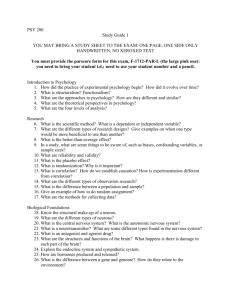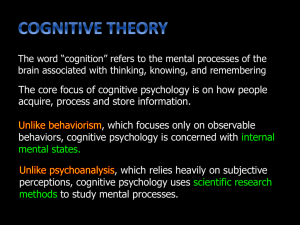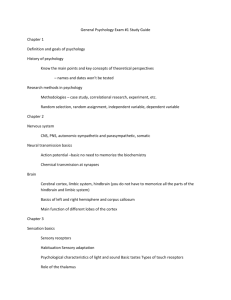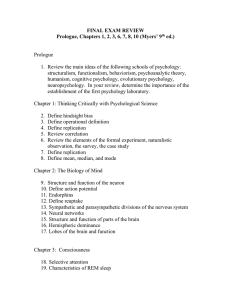Psychology Exam Review
advertisement
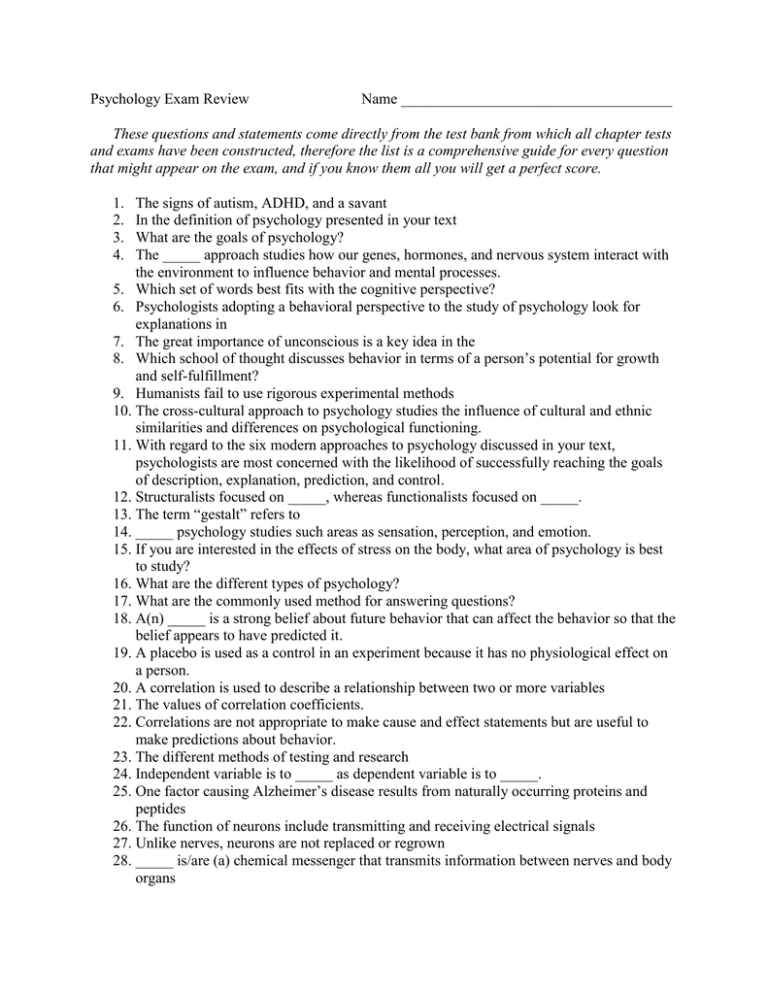
Psychology Exam Review Name ____________________________________ These questions and statements come directly from the test bank from which all chapter tests and exams have been constructed, therefore the list is a comprehensive guide for every question that might appear on the exam, and if you know them all you will get a perfect score. 1. 2. 3. 4. The signs of autism, ADHD, and a savant In the definition of psychology presented in your text What are the goals of psychology? The _____ approach studies how our genes, hormones, and nervous system interact with the environment to influence behavior and mental processes. 5. Which set of words best fits with the cognitive perspective? 6. Psychologists adopting a behavioral perspective to the study of psychology look for explanations in 7. The great importance of unconscious is a key idea in the 8. Which school of thought discusses behavior in terms of a person’s potential for growth and self-fulfillment? 9. Humanists fail to use rigorous experimental methods 10. The cross-cultural approach to psychology studies the influence of cultural and ethnic similarities and differences on psychological functioning. 11. With regard to the six modern approaches to psychology discussed in your text, psychologists are most concerned with the likelihood of successfully reaching the goals of description, explanation, prediction, and control. 12. Structuralists focused on _____, whereas functionalists focused on _____. 13. The term “gestalt” refers to 14. _____ psychology studies such areas as sensation, perception, and emotion. 15. If you are interested in the effects of stress on the body, what area of psychology is best to study? 16. What are the different types of psychology? 17. What are the commonly used method for answering questions? 18. A(n) _____ is a strong belief about future behavior that can affect the behavior so that the belief appears to have predicted it. 19. A placebo is used as a control in an experiment because it has no physiological effect on a person. 20. A correlation is used to describe a relationship between two or more variables 21. The values of correlation coefficients. 22. Correlations are not appropriate to make cause and effect statements but are useful to make predictions about behavior. 23. The different methods of testing and research 24. Independent variable is to _____ as dependent variable is to _____. 25. One factor causing Alzheimer’s disease results from naturally occurring proteins and peptides 26. The function of neurons include transmitting and receiving electrical signals 27. Unlike nerves, neurons are not replaced or regrown 28. _____ is/are (a) chemical messenger that transmits information between nerves and body organs 29. After the release of neurotransmitters in the synapse, neurotransmitters cross the synapse and fit into specially designed receptors located on the second neuron’s dendrites. 30. If a neurotransmitter key opens the receptor’s lock, then the neurotransmitter is said to be excitatory. 31. _____ refers to feeling sensation or pain coming from a limb that has been removed. 32. What is alzheimer’s, parkinson’s, and dementia? 33. What are MRI, PET, and EEG? 34. The two divisions of the nervous system are peripheral nervous system and central nervous system. 35. The ability to perform higher reasoning, speak and use language, and plan is housed in the forebrain. Automatic reactions happen in the midbrain. 36. The medulla controls vital reflexes such as respiration, heart rate, and blood pressure, while the coordination of movement is performed by the cerebellum. 37. The frontal lobe is involved in social-emotional behaviors. 38. The left motor cortex controls the right side of the body while the right motor cortex controls the left side of the body. 39. What do the parietal lobe, occipital lobe and temporal lobes do? 40. The primary auditory cortex turns electrical signals into basic sensations, while the auditory association area turns raw sensory information into recognizable. 41. What are Wernicke’s and Broca’s aphasia? 42. The area of the brain responsible for such primary motives as hunger, thirst, and sex is the hypothalamus. 43. Sympathetic is to arouse as parasympathetic is to calm. 44. What is homeostasis? 45. Basic functions of the Endocrine system, Endophrin system, and Limbic system. 46. Comparing brain size of men and women reveals that the brains of women have more densely packed neurons. 47. The right hemisphere of the brain is better at non-verbal tasks, whereas the left hemisphere is better at verbal tasks. 48. End bulbs release neurotransmitters into the synapse. 49. What are the characteristics of all senses? 50. Where do sensations and perceptions occur? 51. The reason that we can “see” a rainbow is because the light waves are in our visible spectrum. 52. The path that light takes through the your eye is cornea; pupil; lens; retina 53. The primary visual cortex transforms nerve impulses into simple sensations 54. Association areas add meaning to the sensation. 55. Prisms separate light into waves that vary in length. 56. Know dichromat, monchromat, monocular, and binocular. 57. Understand low and high notes and loud and soft volume. 58. Hair cells, rods, cones, cochlea, vestibular, and nerve endings receive stimuli. 59. What are transduction and adaptation. 60. The point above which a stimulus is perceived and below which is not perceived is called a stimulus threshold. JND refers to a 50% chance of perceiving. 61. A perceptual constancy is defined as the tendency to perceive things as unchanging, even though they are changing on the retina 62. Retinal disparity exists because the eye are separated by several inches, each eye receives a slightly different image. 63. Know the different depth perception cues. 64. Know different illusions. 65. Consciousness is defined as different levels of awareness of one’s thoughts and feelings. 66. Know the continuum of consciousness. 67. Know the levels of sleep, SAD, circadian rhythms, and biological clocks 68. What are the different dream interpretations? 69. Know sleep problems. 70. Hypnosis is the situation or set of procedures in which one person suggests to another changes in sensation, perception, cognition, and motor behavior. 71. What is the name of the chemicals that alter our consciousness, sensations, perceptions, mood, and cognitive processes? 72. Among people 12 years and older, what is the most widely used drug? 73. Nicotine causes the most deaths, compared to any other drug? 74. The definition of learning. 75. The differences between classical conditioning, operant conditioning, and cognitive learning. 76. Know discrimination, generalization, spontaneous recovery, and extinction. 77. Four different types of reinforcement and schedules. 78. The four processes necessary for observational learning are attention, memory, imitation, and motivation. 79. Memory is the ability to retain information over time through the process of encoding, storing, and retrieving. 80. Memory process is made up of encoding, storing, and retrieving. 81. Three types of memory are sensory, short-term, and long-term memory. 82. Special memory includes eidetic, echoic, iconic, episodic, and flashbulb. 83. The difference between recall and recognition. 84. Psychometrics focuses on development of psychological tests. 85. An advantage of the multiple intelligence approach is that it recognizes people with different types of intelligence. 86. There is no significant gender difference in intelligence. 87. How to calculate an IQ score and what they are good for. 88. The difference between reliability and validity. 89. The nature-nurture question. 90. Thinking refers to mental processes that we use to be creative, to form concepts, and to problem solve. 91. What are algorithms, heuristics, and prototypes? 92. Deductive vs. Inductive reasoning 93. Convergent vs. Divergent thinking 94. A psychological or physiological factor that causes humans to act in a specific way at a particular time is called motivation. 95. Know instinct, drive-reduction, incentive, and cognitive theories of motivation. 96. Intrinsic vs. Extrinsic motivation 97. Know gender identity, gender role, and sexual orientation. 98. Order and theories of emotion. 99. The use of a lie detector assumes that emotions involve various physiological responses that can be detected, emotions consist of overt behavior, and the subject correctly interprets the question. 100. What is the triangular theory of love? 101. Romantic, hollywood, compassionate, infatuated love. 102. Know the basics about the four personality theories. 103. Stress management programs attempt to change what aspects of our lives? 104. Problems of labels. 105. Difference between insanity and mental disorders 106. Data indicates that the most common mental disorder was substance abuse. 107. Depression is more likely to be found in women while substance abuse in men. 108. Know the basic differences of many phobias. 109. If you were to investigate the case studies of a number of people with dissociative identity disorder, you would probably find that these people usually demonstrate personalities that are very different from each other. 110. Know psychoanalysis, behavior therapy, cognitive therapy, client-centered therapy. 111. If you can’t sleep, read or watch TV in bed to become more drowsy, go to bed only when you are sleepy, and set the alarm to the same time each morning. 112. The right attitude for exams is “I can demonstrate to my professor that I really do know this material.”


